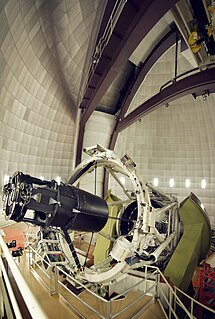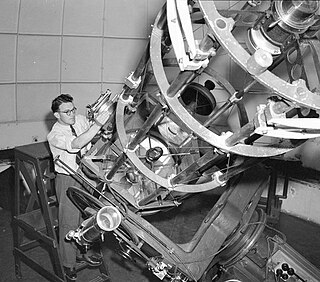Related Research Articles

The Royal Observatory, Greenwich is an observatory situated on a hill in Greenwich Park in south east London, overlooking the River Thames to the north. It played a major role in the history of astronomy and navigation, and because the Prime Meridian passes through it, it gave its name to Greenwich Mean Time, the precursor to today's Coordinated Universal Time (UTC). The ROG has the IAU observatory code of 000, the first in the list. ROG, the National Maritime Museum, the Queen's House and the clipper ship Cutty Sark are collectively designated Royal Museums Greenwich.
Timeline of telescopes, observatories, and observing technology.

Sir George Biddell Airy was an English mathematician and astronomer, and the seventh Astronomer Royal from 1835 to 1881. His many achievements include work on planetary orbits, measuring the mean density of the Earth, a method of solution of two-dimensional problems in solid mechanics and, in his role as Astronomer Royal, establishing Greenwich as the location of the prime meridian.

A refracting telescope is a type of optical telescope that uses a lens as its objective to form an image. The refracting telescope design was originally used in spyglasses and astronomical telescopes but is also used for long-focus camera lenses. Although large refracting telescopes were very popular in the second half of the 19th century, for most research purposes, the refracting telescope has been superseded by the reflecting telescope, which allows larger apertures. A refractor's magnification is calculated by dividing the focal length of the objective lens by that of the eyepiece.
John Pond FRS was a renowned English astronomer who became the sixth Astronomer Royal, serving from 1811 to 1835.

Edward Walter Maunder was an English astronomer. His study of sunspots and the solar magnetic cycle led to his identification of the period from 1645 to 1715 that is now known as the Maunder Minimum.

The Paris Observatory, a research institution of the Paris Sciences et Lettres University, is the foremost astronomical observatory of France, and one of the largest astronomical centers in the world. Its historic building is on the Left Bank of the Seine in central Paris, but most of the staff work on a satellite campus in Meudon, a suburb southwest of Paris.

Eleanor Margaret Burbidge, FRS (née Peachey; 12 August 1919 – 5 April 2020) was a British-American observational astronomer and astrophysicist. In the 1950s, she was one of the founders of stellar nucleosynthesis and was first author of the influential B2FH paper. During the 1960s and 70s she worked on galaxy rotation curves and quasars, discovering the most distant astronomical object then known. In the 1980s and 90s she helped develop and utilise the Faint Object Spectrograph on the Hubble Space Telescope. Burbidge was well known for her work opposing discrimination against women in astronomy.

William Lassell was an English merchant and astronomer. He is remembered for his improvements to the reflecting telescope and his ensuing discoveries of four planetary satellites.

The Anglo-Australian Telescope (AAT) is a 3.9-metre equatorially mounted telescope operated by the Australian Astronomical Observatory and situated at the Siding Spring Observatory, Australia at an altitude of a little over 1,100 m. In 2009, the telescope was ranked as the fifth highest-impact of the world's optical telescopes. In 2001–2003, it was considered the most scientifically productive 4-metre-class optical telescope in the world based on scientific publications using data from the telescope.

The Isaac Newton Telescope or INT is a 2.54 m (100 in) optical telescope run by the Isaac Newton Group of Telescopes at Roque de los Muchachos Observatory on La Palma in the Canary Islands since 1984.

John Gatenby Bolton was a British-Australian astronomer who was fundamental to the development of radio astronomy. In particular, Bolton was integral in establishing that discrete radio sources were either galaxies or the remnants of supernovae, rather than stars. He also played a significant role in the discovery of quasars and the centre of the Milky Way. Bolton served as the inaugural director of the Parkes radio telescope in Australia and established the Owens Valley Radio Observatory in California. Bolton's students held directorships at most of the radio observatories in the world and one was a Nobel Prize winner. Bolton is considered a key figure in the development of astronomy in Australia.

The Royal Observatory, Edinburgh (ROE) is an astronomical institution located on Blackford Hill in Edinburgh. The site is owned by the Science and Technology Facilities Council (STFC). The ROE comprises the UK Astronomy Technology Centre (UK ATC) of STFC, the Institute for Astronomy of the School of Physics and Astronomy of the University of Edinburgh, and the ROE Visitor Centre.

Cambridge Observatory is an astronomical observatory at the University of Cambridge in the East of England. It was established in 1823 and is now part of the site of the Institute of Astronomy. The old Observatory building houses the Institute of Astronomy Library which has a collection of modern and historical astronomical books.
Marek Janusz Kukula is a British astronomer and an author of works on popular science. After gaining a PhD in radio astronomy from the University of Manchester in 1994, he specialised in studying distant galaxies. As his research reached the limits of telescopes, he moved into the field of public engagement. In 2008 he was appointed Public Astronomer at the Royal Observatory Greenwich.

Sidney Charles Bartholemew "Ben" GascoigneAO was a New Zealand-born Australian optical astronomer and expert in photometry who played a leading role in the design and commissioning of Australia's largest optical telescope, the Anglo-Australian Telescope, which for a time was one of the world's most important astronomical facilities. Born in Napier, New Zealand, Gascoigne trained in Auckland and at the University of Bristol, before moving to Australia during World War II to work at the Commonwealth Solar Observatory at Mount Stromlo in Canberra. He became skillful in the design and manufacture of optical devices such as telescope elements.

The Shuckburgh telescope or Shuckburgh equatorial refracting telescope was a 4.1 inches (10.4 cm) diameter aperture telescope on an equatorial mount completed in 1791 for Sir George Shuckburgh (1751–1804) in Warwickshire, England, and built by British instrument maker Jesse Ramsden (1735–1800). It was transferred to the Royal Observatory, Greenwich in 1811 and the London Science Museum in 1929. Even though it has sometimes not been regarded as particularly successful, its design was influential. It was one of the larger achromatic doublet telescopes at the time, and one of the largest to have an equatorial mount. It was also known as the eastern equatorial for its location.
Ian Stewart Glass is an infrared astronomer and scientific historian living in Cape Town, South Africa.
Vincent Cartledge Reddish was a British astronomer who spent much of his career in Edinburgh, where he made significant contributions to British optical astronomy.
The Regius Chair of Astronomy is one of eight Regius Professorships at the University of Edinburgh, and was founded in 1785. Regius Professorships are those that have in the past been established by the British Crown, and are still formally appointed by the current monarch, although they are advertised and recruited by the relevant university following the normal processes for appointing a professorship.
References
- ↑ "C&MS: 157P/Tritton". Archived from the original on 16 March 2006. Retrieved 22 February 2006.
- ↑ "JPL Small-Body Database Browser".